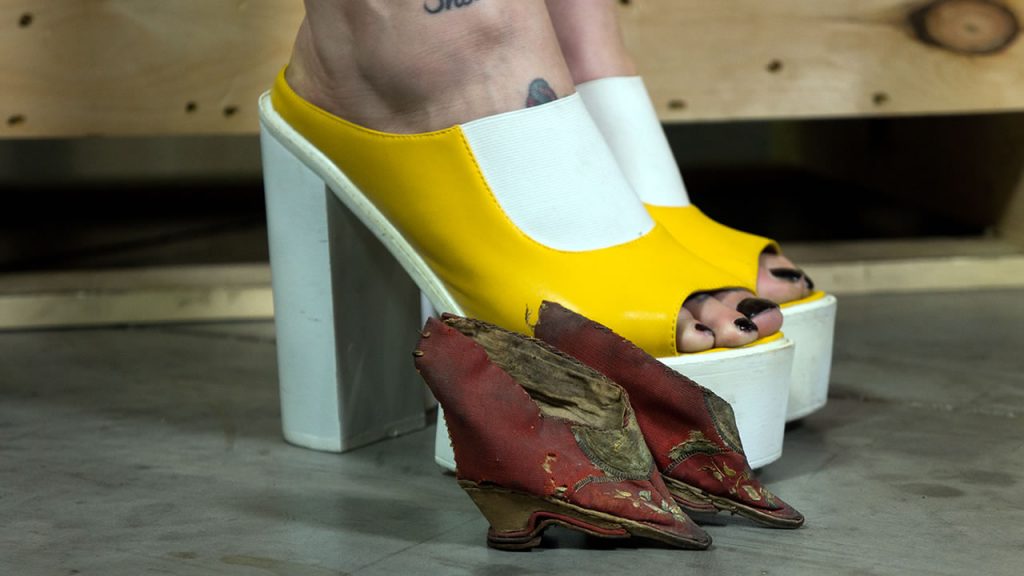Winner of the Fall 2016 StMU History Media Award for
Best Use of Scholarship
Best Article in the Category of “World History”
Best Use of Primary Sources
When I knew I couldn’t suffer another moment of pain and tears fell on my bloody bindings, my mother spoke softly into my ear, encouraging me to go one more hour, one more day, one more week, reminding me of the rewards I would have if I carried on a little longer. In this way, she taught me how to endure—not just the physical trials of footbinding or childbearing, but the more torturous pain of the heart, mind, and soul.1
More often than necessary, women are consumed with the idea of infatuation. Every culture has its own form of standards that pertain to women and what constitutes beauty. Although the world is slightly more accepting now, women used to go to extreme lengths to achieve an image that would be deemed attractive. In the Chinese culture, foot binding was that well-known beauty expectation for centuries. What started off as a celebrity fad, turned into a way of determining social status and eventually an all-around beauty expectation. 2 The objective of foot binding was for women to have the smallest foot possible, starting at very young ages. Not only was this a painful process for girls as young as five years, but it also promoted the idea that women must mutilate their bodies to become appealing to men. At some point in time, women began to just accept that this was something that was supposed to be done in order to be attractive. Often referred to as “lotus boats” or “golden lotuses,” bound feet started as a fad for the famous, and slowly made its way to becoming the social norm.3

This practice began around the tenth century with women in the entertainment business. These women were adored for their tiny arched feet and were seen by men to be much more attractive than middle class women with average feet. As these dancers were gaining an audience, the idea of “lotus feet” was becoming familiar. Not long after these performers expressed their “beauty,” foot binding became a norm for women who wanted to fit in and even for those who had a desire to find a husband.4 This painful process consisted of the breaking of young girl’s toes to form the desired triangular shape. Then the arch of the foot would be bent horizontally from the toes all the way to the heel. As if this was not painful enough, the girls were forced to walk on their feet to intensify the arch, breaking the foot even more. After all of this, the foot would be wrapped to maintain the shape of it as well as prevent any sort of deviation.5

Although this practice was around for centuries, it was only a matter of time before someone realized how inhumane and cruel it really was. Thankfully, many people began to protest against foot binding, forming “anti-foot binding organizations” to raise awareness on the inhumanity of binding women’s feet. By the 1950’s, laws were passed, allowing women to unbind their feet. Although hesitant at first, the trend slowly declined. Many women protested to unbinding their feet, due to the fact that it had been a social norm a thousand years. However, the movement against foot binding continued and eventually the last of the factories that make the tiny shoes were shut down, disabling the women from continuing the custom. Today, foot binding is no longer practiced and the only women who continue to maintain the tiny feet are those elder women who refuse to let go of the past.6
- Lisa See, Snow Flower and the Secret Fan (New York: Random House Publishers, 2005), 3-4. ↵
- Yaodong Gu et al., “Foot Loading Characteristics of Chinese Bound Feet Women: A Comparative Analysis,” PLoS ONE 10, no. 4 (April 2015): 1–9, doi:10.1371/journal.pone.0121695. ↵
- Yu-ning Li, Chinese Women Through Chinese Eyes (New York: Routledge, 2015), 125-127. ↵
- Women in the Middle Ages: An Encyclopedia, 2004, s.v. “Footbinding (Late 10th Century-early 20th Century),” by Patricia Buckley Ebrey. ↵
- Amanda Foreman, “Why Footbinding Persisted in China for a Millennium,” Smithsonian, accessed November 8, 2016, http://www.smithsonianmag.com/history/why-footbinding-persisted-china-millennium-180953971/. ↵
- “Women with Bound Feet in China,” Reshaping the Body: Clothing & Cultural Practice, accessed November 8, 2016, http://exhibits.hsl.virginia.edu/clothes/lady_bound/. ↵



189 comments
Belia Camarena
This article is very well written, and I loved the story like feel the author created. It is so sad to think of what girls in China had to go through. They had to endure the pain of their feet being literally broken while their own mothers encouraged this practice. I found the quote included in the introduction very interesting. It is very strange to hear someone who endured this pain speak of how it prepared them for the trials of life.
Marlene Lozano
It is sad to think that woman had to go through time pain just to fit in with the social norm. I love how this article was written in great detail. The fact that woman would break their toes to bind their feet so that they have a better chance of getting married is heartbreaking. I am glad there are laws against binding that helped put an end to this terrible trend.
Destiny Flores
It’s unbelievable to even think this was a custom that eventually everyone just came to accept. It makes me so grateful at how far women have come to breaking that barrier of having to self mutilate ourselves to be good enough for society. This was really extreme, going as far as permanently disabling women. I would have liked if the article included info maybe a little further into the medical disadvantages, besides the obvious, of doing so.
Anais Del Rio
I remember learning about this practice in one of my history classes and was really fascinated about it. It’s crazy how the mothers of the young girls could bear to see their daughters in so much all for the sake of finding a husband. It reminds me of the China’s modern society where the parents of daughters who are unmarried middle-aged women go to these marriage parks and put up a paper profile of them and people pick and choose someone for their son.
Arianna Kennet
This was a very interesting article. The author mentioned in the very beginning about how throughout time society basically attempts to dictate what is beauty for women and the author is absolutely right. Although, I can not think of anything this cruel and unusual going on today other than possibly facial and body surgeries. There are many examples even in 2018 that show where women attempt to change themselves to fit a standard of beauty.
Caroline Bush
This was a Great article, I can tell you put a lot of time and energy into your research. I had previously heard of foot binding but I did not know that they actually broke young girls feet to get the desired shape. Its sad that young girls had to have their feet broken because society decided that small unrealistic feet were the epitome of beauty. Its unfortunate that this culture took a fad such as small feet and made it into a painful process that young girls were forced to go through so that they would be more attractive to men. I’m glad that they outlawed this practice so no more young girls have to suffer that horrible pain.
Saira Castellanos
I really hate that these young women did this to their feet just to be more appealing to men. It saddens me to know the things that women have done and still do for men. Just like the ring neck ladies in Thailand, they must have endured so much pain. I really wonder what men and women did when they put laws against this. What did they find attractive when this wasn’t allowed anymore? I feel like most all women have done many unnecessary things in order to seem more attractive, and I will admit that I do too. I wish society wasn’t like this, but it is. What really stood out to me in this article was that women were pleasing men in China as young as the age of 5. Children of this age do not have any interest in men it’s so sick to know adults would do this to their kids.
Saira Castellanos
I really hate that these young women did this to their feet just to be more appealing to men. It saddens me to know the things that women have done and still do for men. Just like the ring neck ladies in Thailand, they must have endured so much pain. I really wonder what men and women did when they put laws against this. What did they find attractive when this wasn’t allowed anymore? I feel like most all women have done many unnecessary things in order to seem more attractive, and I will admit that I do too. I wish society wasn’t like this, but it is. What really stood out to me in this article was that women were pleasing men in China as young as the age of 5. Children of this age do not have any interest in men it’s so sick to know adults would do this to their kids.
Lauren Castillo
Amazing! ! Like a documentary you could see it happening. It was so detailed and so colorfully written you could almost feel the pain. It was heart breaking to think people would break their children’s feet especially at such a young age for fear that they might not be married. Thankfully foot binding was put to an end. At least for the most part.
Justin Garcia
This was a very interesting article. Learning about this topic in History class was uncomfortable to say the least. The fact that women use to have to break their feet just to be seen as beautiful is shocking. Though as society has developed trends like this are no longer accepted, trends for beauty haven’t gone away. I believe that is a concern that should be addressed. Overall a great article.